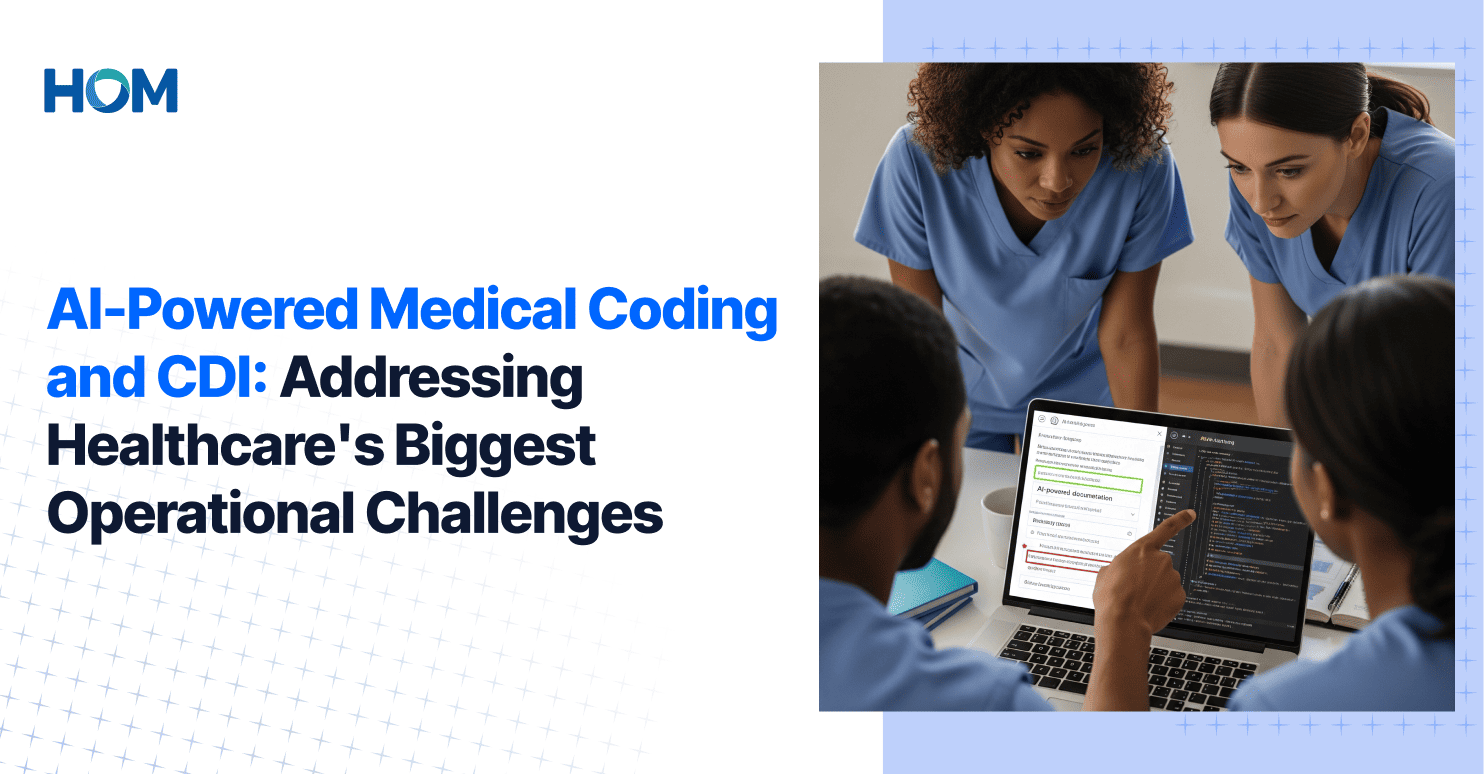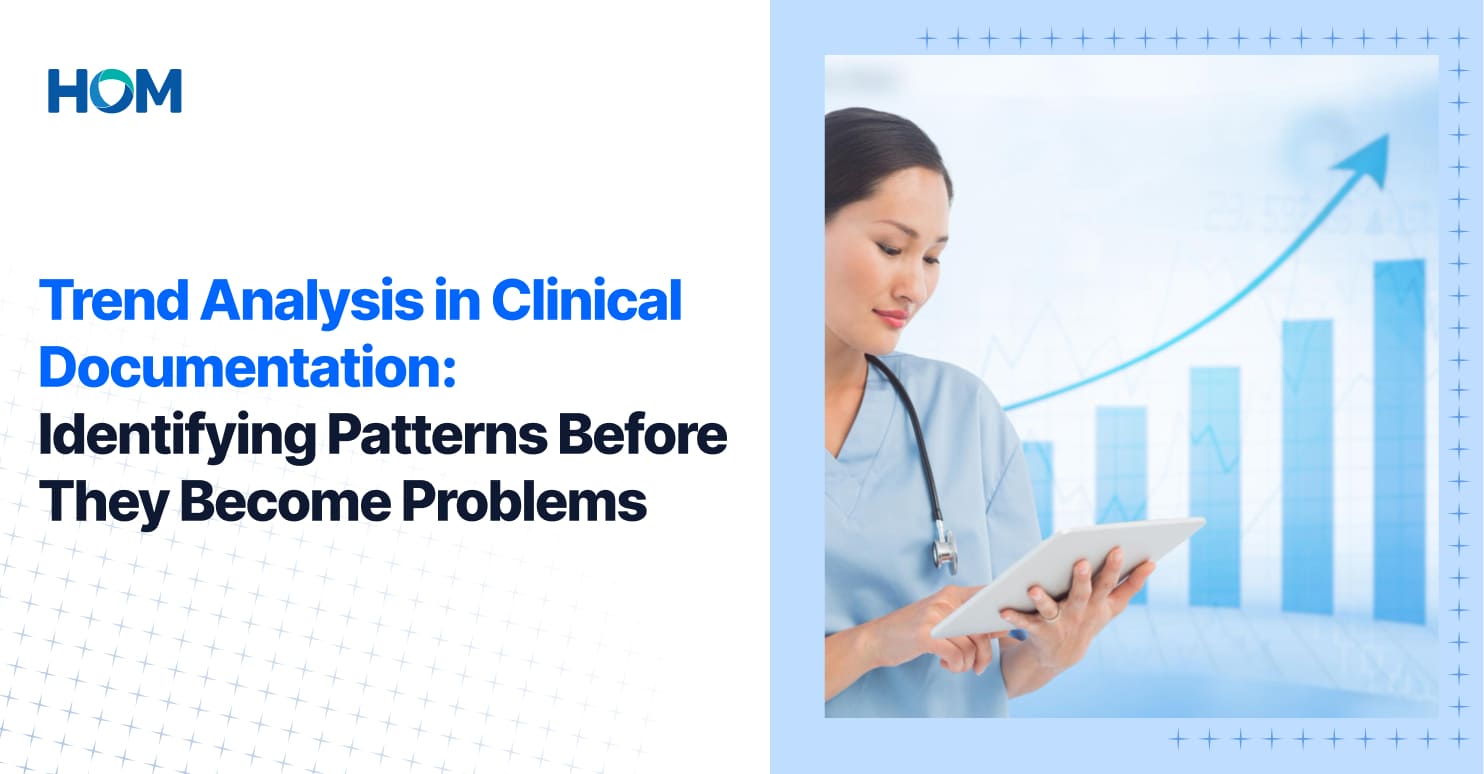
The global healthcare industry today is at a turning point. Providers are navigating rising costs, growing needs of patients, and increasing administrative work. Manual processes in revenue cycle departments remain a bottleneck, with claim denial rates hovering near 20%. On the other hand, the Clinical Documentation Improvement (CDI) sector is projected to double in 2034, clearly signalling the pressing need for stronger documentation practices. With almost 8 years of experience in this evolving space, HOM has witnessed these challenges firsthand and understands the critical need for innovative solutions.
Against these operational challenges, AI in healthcare offers a practical solution, not by replacing skilled professionals, but by supporting and improving their work. By taking over repetitive tasks, surfacing elusive gaps in documentation and coding in real-time, and enabling faster decision-making, AI is helping teams focus on high-value tasks.
As you explore how AI in RCM positively transforms medical coding and CDI, you will understand how it’s helping build proactive and accurate processes that protect patient care and revenue integrity.
Healthcare Industry’s Operational Crisis and Revenue Cycle Impact
High denial rates and administrative complexities are among the biggest challenges, with healthcare practitioners particularly worried about recovering payments owed by patients on time, managing denials, and hiring and training staff.
Coding and Documentation – A Growing Concern
Medical coding departments face a different kind of pressure. Due to the time-intensive nature of manual code review and assignment, organizations struggle with delayed claim processing, which eventually leads to backlogs and claim rejections.
Provider organizations often face substantial revenue loss from underbilling, with individual practices, especially in radiology or oncology, reporting annual losses in the hundreds of thousands.
The CDI process suffers equally. According to the Change Healthcare Revenue Cycle Denials Index, approximately 31% of claim denials are deemed unequivocally avoidable. Of these, 43% are recoverable.
These denial statistics directly correlate with front-end documentation issues, as the foundation of clean claims begins with accurate initial documentation. Half of these errors stem from the front end, where manual documentation processes are most vulnerable. Staff burnout only amplifies these problems.
Organizational Impact and the Need for Change
This vicious cycle affects every aspect of an organization. Cash flow becomes unpredictable when claims are delayed or denied. When analysts spend hours working through charts or reworking claims, their focus shifts from patient care to administrative firefighting.
And as documentation gaps go unnoticed until audit time, the risk of regulatory compliance violations multiplies. The traditional approach - hiring more staff or asking teams to extend work hours - no longer serves as a sustainable solution. This is where AI’s value becomes clearer, not as an abstract element but as a practical solution built to close these specific gaps.
Proven Value of AI in Medical Coding and CDI Operations
HOM’s AI-integrated solutions demonstrate this perfectly by working alongside existing CDI and medical coding teams. The key difference is that AI-powered coding and CDI move from reactive problem-solving to proactive prevention. Let’s look at how AI in RCM creates value:
Intelligent Pre-Review and Pattern Recognition
AI solutions scan thousands of medical records in minutes and identify patterns that would take hours for human analysts to spot. They don’t just find obvious errors; instead, they detect subtle inconsistencies and highlight prospects that human eyes might miss during rushed reviews.
HOM’s AI solutions achieve 95% accuracy in pattern recognition and irregularity detection, and CDI teams receive targeted alerts about charts that need attention.
AI engines learn from an organization’s historical data and coding patterns. Over time, it becomes better at identifying the most common types of issues in a specific provider, practice, or facility. This personalized approach makes alerts and recommendations increasingly relevant and action-oriented.
Smart Evidence Detection
Traditional clinical documentation improvement review is often slow and draining, where coders read through long progress notes, surgery reports, and discharge summaries to piece the full clinical story together. In contrast, AI can evaluate these documents at once, cross-check information across multiple sources, and highlight evidence needed to support a diagnosis or procedure.
For coding teams, this means working with charts that already have the key clinical indicators flagged. Instead of spending 30 to 45 minutes per chart looking for supporting details, they can put their energy into what matters most: making accurate medical coding decisions backed by clearly presented information.
HOM's proven efficiency displays this advantage, achieving 48-72 hour turnaround times while processing millions of charts with unprecedented speed and better-than-industry-average accuracy.
Automated Query Generation and Response Tracking
The effectiveness of queries directly impacts revenue recovery, but most organizations struggle with low physician response rates. AI helps analyze historical query data to identify which types of requests generate the highest response rates and best clinical clarifications. AI can also suggest a query language that’s more likely to get actionable answers.
Advanced systems track query patterns over time, helping you find out providers who may need additional training or documentation support. This data-driven process changes query management from guesswork into strategic communication.
Resource Allocation Through Predictive Analytics
AI-powered dashboards present historical data to predict cases that are more likely to contain high-value opportunities or documentation gaps. The capability allows leaders to allocate staff resources more effectively. AI can also forecast workload patterns and empower healthcare organizations to be ready for seasonal fluctuations.
Real-Time Performance Monitoring
AI dashboards provide real-time visibility into coding productivity, response rates of queries, denial patterns, and revenue impact. This immediate feedback allows managers to identify and address issues before they escalate. AI-derived analytics can go beyond basic metrics to spot patterns and correlations that might not be obvious. For example, the system may show that certain cases often need extra clarification from specific providers, pointing to where targeted training could help.
AI is Here to Assist, Not Fix
The question isn’t whether AI will change medical coding and CDI operations; it’s already happening. The real question is how organizations will adapt to work alongside these powerful tools while preserving the irreplaceable human expertise.
- By handling repetitive tasks, AI solutions can free up teams to focus on clinical judgment, patient interaction, and critical thinking, especially at a time when costs are rising and staff are stretched thin.
- CDI specialists bring years of clinical experience and understanding of complex medical conditions that AI cannot replicate. What AI can do is scan records, flag issues, and organize information in real-time, allowing experts to focus more on challenging cases.
- Similarly, medical coding professionals rely on their knowledge of coding guidelines, clinical context, and payer requirements that technology cannot match. AI can suggest codes, but accuracy and compliance largely rest on its judgment.
- Adopting AI is not about learning new technical skills but about understanding how it supports existing expertise. Building trust will come through pilot programs, transparency, and real results.
Preparing for AI-Integrated Medical Coding and CDI
AI adoption in medical coding and CDI shouldn’t be a one-time initiative, but a steady shift towards proactive processes. You need to balance technology with people, policies, and processes, which denote:
- Build on AI’s long history in healthcare, starting with solutions that support existing workflows instead of overhauls.
- Prioritize staff development through AI literacy, prompt practice, and safe internal experiments.
- Focus on integration, not substitution. AI should support reasoning and judgment, with human oversight and compliance safeguards. Continuously highlight the irreplaceable value of experienced medical coding experts and CDI professionals for their clinical insight, ethics, and logic.
- Avoid over-relying on automation; set clear guidelines to ensure quality, compliance, and audit safety.
Long-term success with AI integration will depend on choosing providers that design tools specifically for healthcare workflows rather than generic business solutions. HOM has a proven track record of serving over 300 physician practices, hospitals and healthcare systems, and TPAs with AI-integrated healthcare management solutions for 8 years.
Final Thoughts
Artificial intelligence could be the most powerful tool to ease operational strain in medical coding and CDI, but it’s not a cure-all solution. By reinforcing CDI and medical coding processes, AI in healthcare can help reduce the denial rate, improve regulatory compliance, and protect revenue integrity from the very beginning.
Healthcare organizations that will succeed with AI integration are those that view the technology as a strategic investment in operational efficacy and staff fulfillment.
HOM has seen firsthand the impact of operational challenges. We know that integrating AI successfully requires strong healthcare expertise, effective change management, and continuous support.
That’s why our approach combines advanced AI-driven solutions, AHIMA/AAPC-certified professionals, and a deep knowledge of revenue cycle management. We deliver measurable results across 15+ medical specialties and have helped organizations reduce admin work by up to 35%, revenue leakage by 90%, and overall cost by 80%.
Contact partnerships@homrcm.com to learn how AI-integrated CDI and medical coding can transform your organization’s financial performance. You can also book your free audit.
Bring a change to your Healthcare Operations
A partnership with HOM gives you an inherent:
Connect with our experts for a quick analysis and possibilities.

















